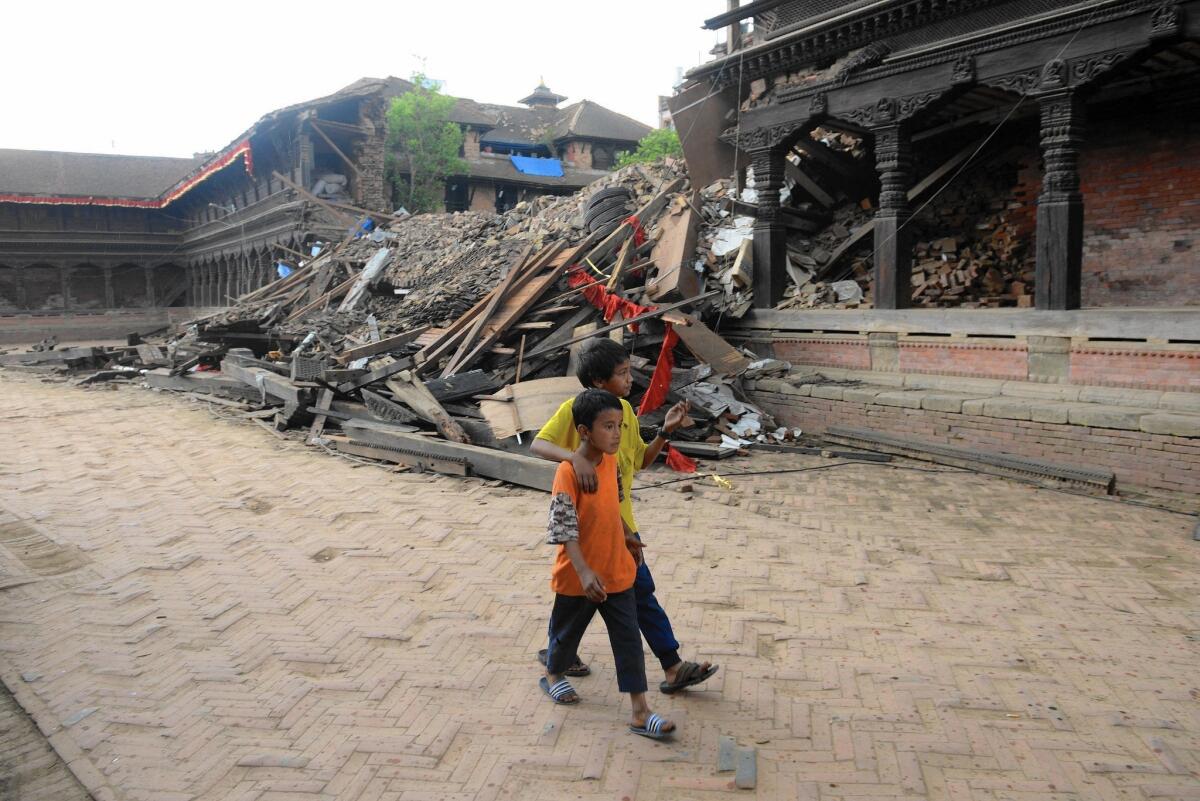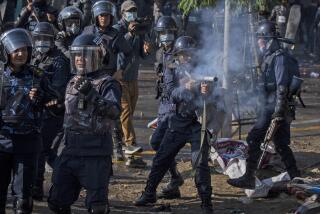Ancient temples, key to Nepal tourism, suffer severe quake damage

- Share via
Reporting from KATMANDU, Nepal — The gates of Dharahara, an ancient nine-story tower overlooking the city skyline, were locked Monday, its ticket booth shuttered.
Yet hundreds of residents clambered over its low walls to climb the rubble heap where it once stood and snap photographs. Some left holding still-ornate pieces of the ancient structure.
In Katmandu Durbar Square, only a few hundred yards west of Dharahara, mounds of brick and splintered wood marked the former site of two ancient temples, one of which, according to legend, was built with wood from a single tree.
Balram Khatri, 22, lamented the loss: “These are very important symbols for Nepalese,” he said, “and for the whole world as well.”
Two days after Nepal’s capital, Katmandu, was rocked by its worst earthquake in 80 years, residents have been heartbroken to find that many of its best-known historical sites — centuries-old temples, palaces and monuments, symbols of the city’s rich cultural and religious life, have been reduced to rubble.
In some places, the devastation has been wholesale. Before the magnitude 7.8 earthquake struck Saturday, killing thousands of people, the Katmandu Durbar Square, Bhaktapur Durbar Square and Patan Durbar Square were ancient royal complexes, all classified as World Heritage sites by the United Nations’ cultural organization UNESCO. Within minutes of the quake, they were piles of timber, stone and dust.
“I am deeply aggrieved by the magnitude of human loss caused by the earthquake in Nepal,” Irina Bokova, the organization’s director-general, said in a statement. “I am also shocked by its devastating impact on the unique cultural heritage in the country, in particular extensive and irreversible damage at the World Heritage site of Katmandu Valley.” The organization has sent a team to Katmandu to assess the damage, the statement said.
Katmandu’s historical sites were not uniformly razed — the ancient Shiva Bhairavnath Temple is still standing, according to Britain’s Daily Telegraph newspaper. Although the Krishna Mandir, built of solid stone, withstood the shock, the adjacent Hari Shanker and Uma Maheswar temples were destroyed by the temblor.
Gary Shaye, the humanitarian affairs coordinator for Save the Children, who once led the organization’s operations in Nepal, said the sites were not simply old monuments and tourist attractions — they were vibrant community centers.
“These are living temples,” he said. “People pray there all the time. So the cultural loss is also immense.”
Even among rubble-strewn sites, experts say they have just begun to survey the extent of the damage.
“We will have details about the damage in the cultural heritage site of Patan only when we are able to get inside the centuries-old courtyards here,” said Rohit Ranjitkar of Katmandu Valley Preservation Trust, an independent organization that had been working on restoration projects in the square.
Saraswati Singh, director of the Katmandu square’s Hanuman Dhoka Museum, said that damage to the structure remained difficult to ascertain.
“We’ve only been able to roughly assess the damage in the outer courtyard. There could still be many fragile structures that could tumble any moment,” he said. The square typically received about 800 visitors daily, making it one of the most popular tourist destinations in the capital, he added.
Conservationists fear not just losing an important slice of living history, but also the disaster’s ripple effects on tourism, a pillar of the city’s economy. “These three squares were all that remained of Katmandu’s important cultural heritage,” said Rabindra Puri, a preservationist from Bhaktapur, a historical city on Katmandu’s outskirts. “Local communities who relied on tourism in these areas will be hit hardest.”
“All of our pleas to invest sufficiently in these heritage sites were never heeded,” he added. “And now the locals have to pay for it dearly.”
Special correspondent Rai reported from Katmandu and Times staff writer Kaiman from New York. Staff writer Alexandra Zavis in Los Angeles contributed to this report.
More to Read
Sign up for Essential California
The most important California stories and recommendations in your inbox every morning.
You may occasionally receive promotional content from the Los Angeles Times.










